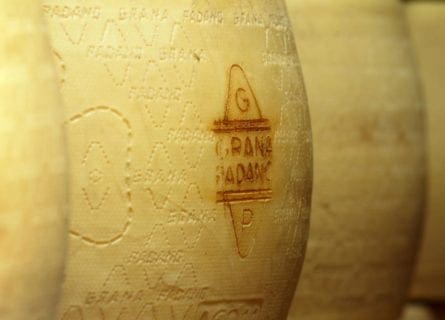
A Taste of Piacenza: Discovering Authentic Emilia-Romagna Cuisine
November 18, 2023
Explore Piacenza's culinary treasures in our guide. Discover Emilia Romagna's authentic flavors, from wines to artisanal cheeses. A must-read for foodies!
By: Nicole Dickerson / Last updated: November 16, 2023
Estimated reading time: 16 minutes
Located in central Italy, Lazio is nestled between Tuscany, Abruzzo, Molise, Campania, and the Tyrrhenian Sea. This Italian region is home to Rome, the Eternal City, where thousands of travelers visit annually to experience the city’s illustrious history, architecture, and art. Rome has many celebrated sites worth exploring, from the Colosseum to the Vatican, the Sistine Chapel, the Pantheon, and more. Fortunately, the Eternal City boasts equally enchanting culinary traditions, making Rome a must-visit destination for foodies. Roman food embraces simplicity and a no-waste philosophy.
Firmly rooted in the Italian cuisine customs of cucina povera or poor cooking, Roman cuisine seamlessly transforms humble ingredients into gastronomic art worthy of a city housing the works of Michelangelo, Bernini, and Caravaggio. Let’s explore the cuisine of Lazio and the best food to eat in Rome so you can make the most of your next food & wine tours to the most fantastic city in the world.

Guide to Italian Gastronomy and Cuisine: Read more
Cheese is a staple in Roman cuisine and the Lazian diet, as with other Italian regions. Here are the four most common kinds of cheese you’ll likely savor in Lazio.
Pecorino Romano PDO cheese is made from the milk of sheep who graze freely in Lazio and Sardinia. This cheese was once a staple in the diet of Roman soldiers because of its extended shelf-life. From Pliny the Elder to Hippocrates, even ancient Roman authors mentioned Pecorino Romano in their written works. Salting the wheels of Pecorino Romano multiple times over their eight-to-twelve-month aging period results in this cheese’s salty, sharp, piquant trademark taste. When young, Pecorino Romano has a sweet, aromatic flavor. The cheese ages with a sharper, smokier flavor as it becomes more granular and crumbly.
Produced in the Lazian province of Frosinone throughout the Comino Valley, Pecorino di Picinisco is a hard, uncooked cheese made with raw sheep’s milk. It’s coagulated exclusively with lamb rennet. This production process imparts the aromas and flavors of mountain pastures where the sheep graze. It’s made in a partially aged style called Scamosciato and a fully matured style called Stagionato. Scamosciato offers a sweeter flavor, whereas the Stagionato is more intensely flavored with spicy notes.
An ancient dairy product from the province of Rome, Ricotta Romana, is made throughout Lazio today, where natural grazing ensures the highest traditional quality. Ricotta Romana is produced exclusively from the whey of sheep’s milk, a byproduct of Pecorino cheese production. This whey is reheated in a process called ricottura, where ricotta’s name is derived. While reheating the whey to 85-90°C, it’s stirred with a special wooden stick, aiding the coagulation process. Small flakes of coagulated whey rise to the top and are collected in molds called ‘canestretti bucati,’ which shape the cheese. Ricotta Romana is known for its delicate, sweet flavor and should be consumed fresh.
Conciato Romano is recognized as one of the oldest cheeses in the world and is known for its powerful aromas and intense flavors. The likes of Pliny the Elder and Martial wrote about this cheese. It’s named for the ancient technique of tanning animal hides with oil, as a similar process is used to make the cheese. Today, Conciato Romano is made with the milk of sheep, goats, or cows and goat rennet. First, the cheese is hand-pressed into small molds, salted, and dried in beechwood farmhouses. Then, it’s seasoned with local extra virgin olive oil, a regional wine from Casavecchia grapes, thyme, oregano, and chili pepper. Conciato Romano ages eight months in amphorae or glass jars, allowing the cheese to develop its intense flavors.
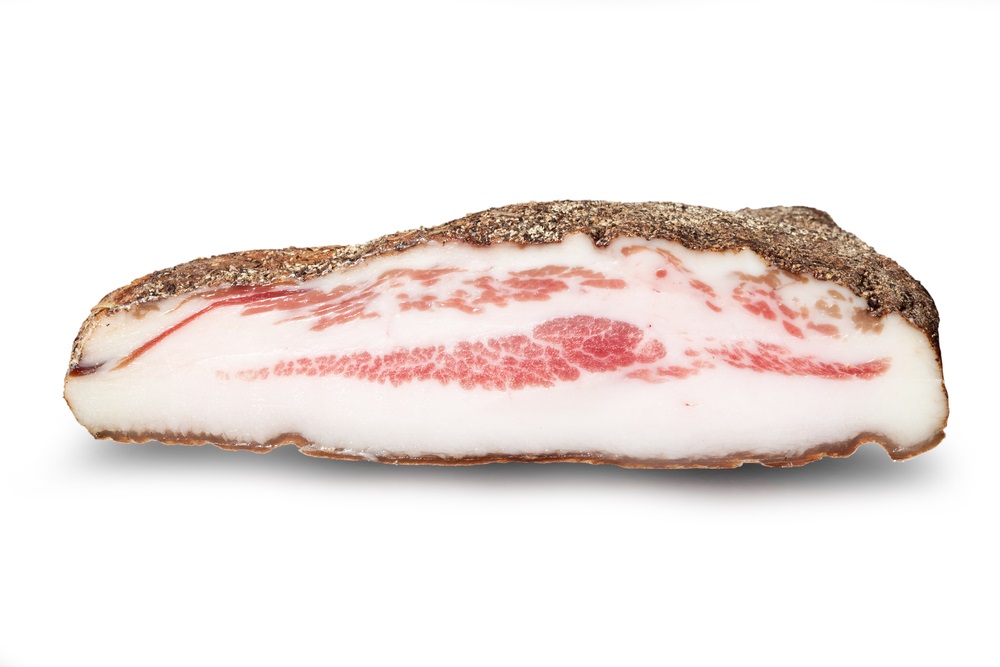
Guanciale is a crucial ingredient in Lazian and Roman cuisine and the star of some of the best pasta in Rome. It’s made from fatty pork jowls, rubbed with salt and black pepper, then aged for at least three months. In Lazio, guanciale is also seasoned with garlic. Though it can be eaten raw, guanciale is frequently used instead of oil for cooking. The rendered pork fat contributes a depth of flavor to dishes like bucatini all’Amatriciana and spaghetti alla Carbonara.
Located in the province of Rieti, Amatrice is a gastronomic center of Lazio. It’s home to two of region’s most popular salumi, mortadella di Amatrice and prosciutto di Amatrice. Mortadella di Amatrice is made from ground pork meat taken from the loin and shoulder of the pig. The meat is seasoned with salt and pepper and left to cure inside a natural casing. Then, after being pressed, mortadella di Amatrice is left to age for four months, resulting in a more intensely flavored and darker mortadella than its more famous counterpart from Bologna. Mortadella di Amatrice can also include a stick of pork fat through the center.
Prosciutto di Amatrice has been made in Lazio since the Middle Ages when feudal lords demanded prosciutto as a tax from the vassals who used their land. Under today’s protected PGI status, it can only be made with the Duroc, Landrace, and Large White pig breeds. First, much of the fat is removed from the ham, which is salted twice over two to three weeks. It’s then washed, dried, and covered in lard and spices before curing over twelve months. The resulting prosciutto di Amatrice is known for its delicate, balanced flavors and intense aromas.
If you’re a beef jerky fan, seek out copiette in the Castelli Romani area of southeast Rome. Traditionally, copiette was made from the more challenging parts of grazing animals like sheep, goats, horses, and donkeys. Today, copiette is a chewy pork jerky made from thinly sliced strips of pork tenderloin cured in salt, chili peppers, and fennel seeds.
A prime example of the no-waste traditions of cucina povera in Lazio is susianella, which is a pork offal sausage. It’s made from the offcuts of pork like liver, pancreas, heart, cheeks, etc. The offal is ground and seasoned with pepper, fennel, and chili pepper, then left to cure for one to six months in a pork casing. Susianella has earthy flavors, which become more intense with age.
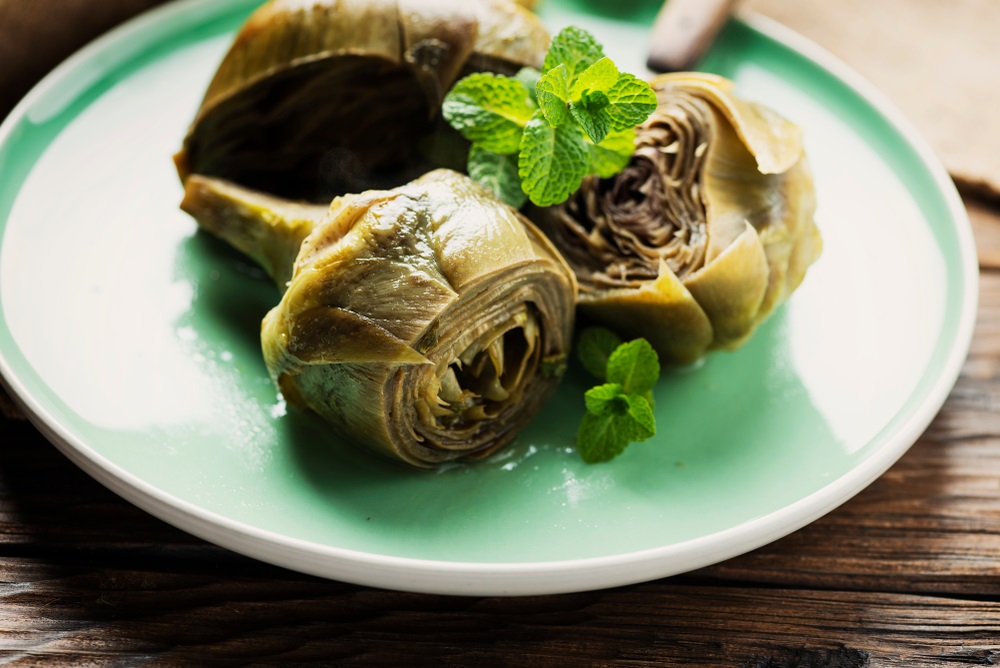
Artichokes, or carciofi, are a popular appetizer in Roman cuisine, and many preparations feature the local variety called Romanesco artichokes, also known as cimarolo or mammola. These artichokes have a round, flattened shape, and trademark sweet flavor. They are thornless and grow near the coast. Carciofi alla Romana sees the artichokes cleaned, then placed stem up in a pan. A mixture of olive oil, salt, pepper, minced garlic, mint, lemon, and a splash of vinegar are added to the pan. The artichokes braise in this liquid until tender and are served immediately.
The Jewish community has an extensive history in Rome. In 1492, Spanish Jews were expelled from Spain, and many found refuge in the Eternal City. However, in 1555, Pope Paul IV created the Jewish ghetto in Rome and forced all Jews living in Rome and the surrounding areas to move there. Judeo-Roman cuisine was born in the Jewish ghetto, and carciofi alla giudia is a well-known recipe still widely enjoyed today.
Carciofi alla Giudia can be enjoyed as an antipasto or contorno (side dish). Romanesco artichokes are trimmed down to their hearts and cleaned, then marinated in lemon water. Finally, the artichokes are seasoned with salt and pepper and fried in olive oil until deliciously crispy. Learn more about Rome’s Jewish culinary traditions here.
Carciofi alla matticella was first created in the peasant traditions in Velletri. Traditionally, viticulturists planted artichokes at the ends of their vine rows. Then, when the vines were pruned in January, they’d make a bonfire with vine shoots, known as matticelli. They’d then cook their harvested artichokes in the embers of those fires.
The original recipe saw the artichokes doused in olive oil, seasoned with salt, and placed in the fire embers. This cooking process gives the artichokes a savory, smoky flavor. Today, fresh mint and garlic also flavor the artichokes.
Found seasonally in Rome from November to April, puntarelle are the sprouts of a unique type of Catalonian chicory. They’re prepared as an appetizer by removing the outer leaves and soaking the puntarelle in cold water, which causes them to take their distinctively curly shape. Next, the puntarelle is seasoned with a dressing of mashed anchovies, garlic, olive oil, salt, and chili flakes for a delectably crunchy, fresh Roman antipasto.
One of Rome’s street food gems, supplí, echoes the Sicilian arancini. These delectable fried rice croquettes are crafted from rice simmered in a savory tomato meat sauce and generously filled with mozzarella. Famously known in Rome as supplí al telefono, they are celebrated for the tantalizing strands of melted cheese that stretch like telephone cords when pulled apart, creating a delightful culinary experience.
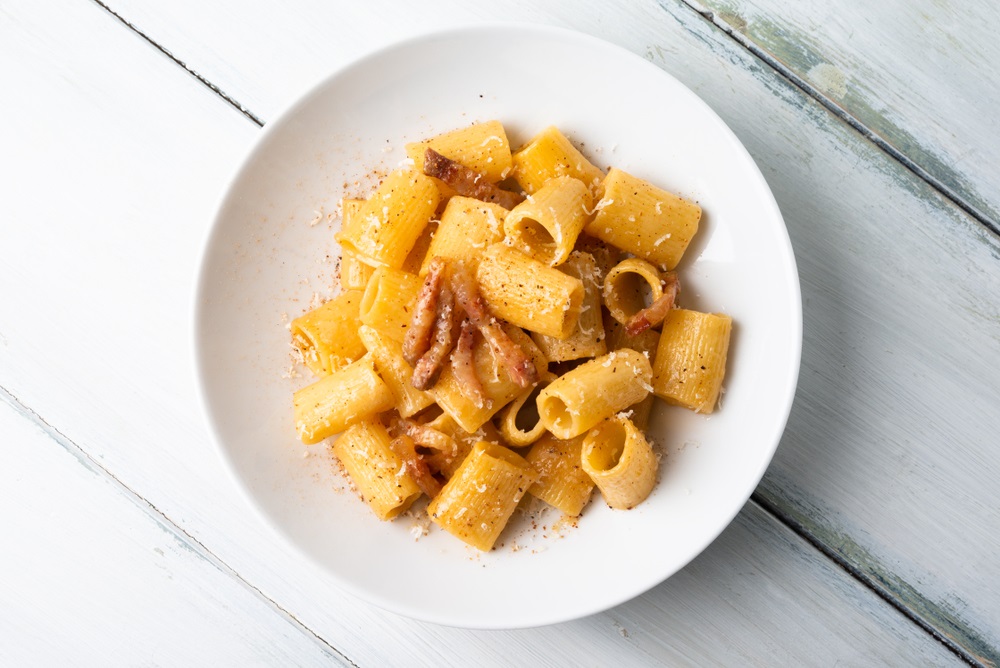
No trip to Rome is complete without savoring at least one (if not all) of these classic Italian pastas from Lazio.
Considered the foundation of other Roman pasta dishes, pasta alla Gricia is made with a humble combination of Pecorino Romano cheese and guanciale. The thick layer of fat on guanciale is ideal for rendering into a flavorful pasta sauce. However, the trick is to render the pork fat without unnecessarily browning the guanciale. Once the fat is rendered, a splash of pasta water is added to the pan to emulsify the fat. Next, pasta cooked just short of al dente is added to the pan, along with more pasta water to create a rich sauce. To serve, pasta alla Gricia is tossed with grated Pecorino Romano and a few grinds of black pepper. Explore the history of pasta alla Gricia here.
While various iterations of spaghetti alla Carbonara are savored globally, the authentic Lazio version adheres to a simple yet exquisite recipe. It combines only spaghetti, guanciale, Pecorino Romano, eggs, and black pepper. This dish shares its initial steps with pasta alla Gricia, adding eggs to the sauce, enriching its texture and flavor. To finish, egg yolks are whisked with grated Pecorino Romano and gently folded into the pasta away from direct heat. A splash of pasta water is incorporated to emulsify the sauce smoothly. The dish’s name, “Carbonara,” pays homage to the carbonaro or charcoal burner, nodding to the charcoal workers who historically cherished this hearty meal.
Hailing from the town of Amatrice in Lazio, bucatini all’Amatriciana takes pasta alla Gricia one step further with the addition of tomatoes. Rather than just adding water to the rendered guanciale, tomatoes are added to create a sauce with more depth of flavor. In addition, grated Pecorino Romano further enriches the sauce. While bucatini is the traditional pasta for all’ Amatriciana, spaghetti, and rigatoni also work well.
Cacio e Pepe, literally translating to “cheese and pepper,” is a deceptively simple yet richly flavored dish that requires skillful preparation. The key to its success lies in the technique: pasta cooked slightly al dente, is transferred to a pan along with a few spoonfuls of its starchy cooking water, freshly ground black pepper, and a generous amount of grated Pecorino Romano cheese. The magic happens as the starch from the pasta melds with the cheese, creating a luxuriously smooth and glossy sauce. This sauce perfectly clings to the pasta, typically spaghetti or tonnarelli, resulting in a classic Roman dish that’s both comforting and sophisticated.

Another flavor-packed yet straightforward pasta dish, spaghetti aglio e olio, demonstrates the peasant-style traditions of cucina povera. Spaghetti is seasoned with a sauce of minced garlic and chili peppers sautéed in olive oil. The oil takes on the flavors of the garlic and pepperoncino, coating the spaghetti with a spicy kick.
Next, penne all’Arrabbiata also packs a spicy punch. Arrabbiata means angry, referencing how this intensely spicy sauce, made from tomatoes, olive oil, garlic, and chili peppers, can make you red in the face.
Gnocchi alla Romana are a wholesome primo piatto from Lazio. The gnocchi is made with semolina flour enriched with eggs, Parmigiano Reggiano, milk, and butter. They develop an irresistible crispy crust while cooking. Gnocchi alla Romana was traditionally eaten on Thursdays to compensate for lighter Friday meals when Catholics abstained from eating meat.
Finally, rigatoni con la pajata is a classic Roman peasant dish. La pajata refers to the intestines of calves weaned solely on their mother’s milk. The intestines are cleaned and cooked with the milk the calves had eaten still inside. When cooked, la pajata forms a thick, creamy sauce made with onions, tomatoes, celery, carrots, white wine, and spices, typically served with rigatoni.
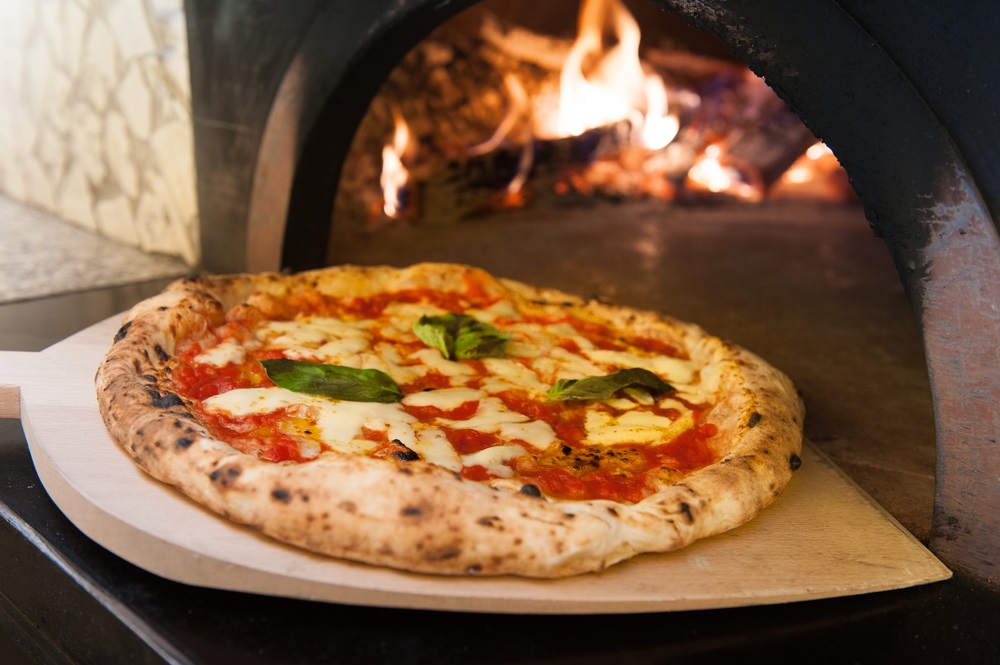
In Rome, you’ll discover the distinct pizza Romana, known for its thin, crispy base, contrasting the softer, thicker Neapolitan style. It features a flatter crust and classic toppings like tomato sauce, anchovies, capers, basil, and Pecorino Romano cheese. Another Roman favorite is pizza al taglio, a rectangular pizza with a moister, thicker dough, typically served by the slice. The quintessential pizza al taglio boasts simple toppings of tomato sauce and a drizzle of olive oil.
Additionally, Rome offers pizza bianca Romana, a sauceless variant reminiscent of focaccia. This oven-baked delight is soft and thick, garnished minimally with salt, olive oil, and occasionally rosemary for a simple yet satisfying flavor.
Venturing to the seaside town of Gaeta, you’ll encounter the unique tiella di Gaeta. This stuffed pizza artfully combines land and sea flavors, featuring octopus, local Gaeta olives, tomatoes, zucchini, onions, and escarole. It’s a popular choice for a savory street food snack, typically enjoyed by the slice.
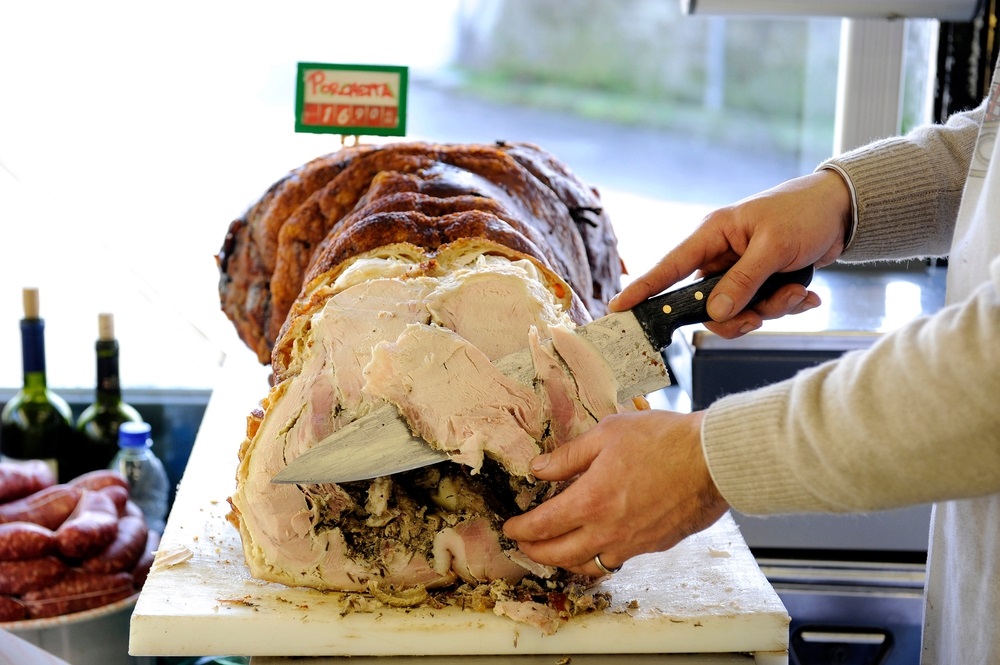
Porchetta di Ariccia is a pork roast that’s become a culinary legend in Roman cuisine. It’s made by stuffing deboned pigs with seasonings like fennel, rosemary, and garlic. The pigs are then slowly spit-roasted over a wood-burning fire until the skin is crispy and the meat is juicy and tender. Porchetta di Ariccia is often served as street food at festivals and markets, with the succulent meat used as a filling for sandwiches.
Tripe is revered in Roman cuisine as part of the ‘quinto quarto’ tradition, reflecting Rome’s historical approach to offal. Quinto quarto, meaning the ‘fifth quarter,’ encompasses all the edible internal organs of an animal, including tripe, kidneys, liver, spleen, and sweetbreads. Historically, meat distribution in Rome was stratified by social class until the early 20th century. The finest cuts were reserved for nobility and clergy, followed by the bourgeoisie and soldiers. The remaining offcuts, collectively termed the ‘fifth quarter,’ were allocated to the working-class populace. This practice gave birth to the quinto quarto culinary tradition, a testament to resourcefulness and the art of cooking with offal.
Trippa alla Romana is an example of a quinto quarto. It is traditionally cooked with tomato, onion, garlic, carrot, and white wine and seasoned with Pecorino Romano and nepitella, a cross between mint and oregano.
Coda alla vaccinara, a hallmark of Roman cuisine, is a sumptuous oxtail stew deeply rooted in Rome’s ‘quinto quarto’ tradition, where oxtail was prized as a ‘fifth quarter’ cut. Modern renditions of this beloved dish involve braising the oxtail with golden-browned pancetta or lardo, rich tomato purée, wine, and a mélange of carrots, celery, and leeks. Herbs like thyme, bay leaves, and a hint of nutmeg are commonly used to infuse flavor. In keeping with tradition, some recipes also incorporate cinnamon, raisins, pine nuts, and a touch of chocolate, adding layers of complexity. Served atop a bed of creamy polenta, coda alla vaccinara offers a hearty and rustic culinary experience.
Pollo alla Romana is a Roman dish from Castelli Romani in Lazio. It’s made with different cuts of chicken slow-cooked with onions, garlic, white wine, pancetta, tomatoes, and bell peppers. Then, while simmering together, a flavorful sauce forms and coats the chicken.
One of the most traditional recipes from Roman cuisine, saltimbocca alla Romana, features tender veal cutlets wrapped with prosciutto and fresh sage. The cutlets are sautéed in white wine, resulting in a flavorful dish that jumps in the mouth, hence the name salti in bocca.
Abbacchio is the name for a milk-fed lamb, a springtime delicacy around Easter in Roman cuisine since ancient times. The lamb is marinated and stewed slowly with olive oil, rosemary, sage, garlic, vinegar, and anchovies. Abbacchio alla Romana offers a succulently tender, aromatic meat with a savory, salty kick, often served with roasted potatoes.
This classic Roman dish was created to utilize the leftover meat boiled to make brodo; usually, veal is cut into smaller pieces and sautéed with tomato sauce, celery, carrot, onion, red wine, and basil or mint. Bollito alla picchiapò is usually served with mashed potatoes or polenta.
Especially popular on Christmas Eve, baccalà fritto alla Romana is a preparation of fried codfish often found as street food in Trastevere. The fish is coated in a simple batter of flour and cold sparkling water and then fried until golden brown and crispy. Baccalà fritto alla Romana is only served with lemon wedges.
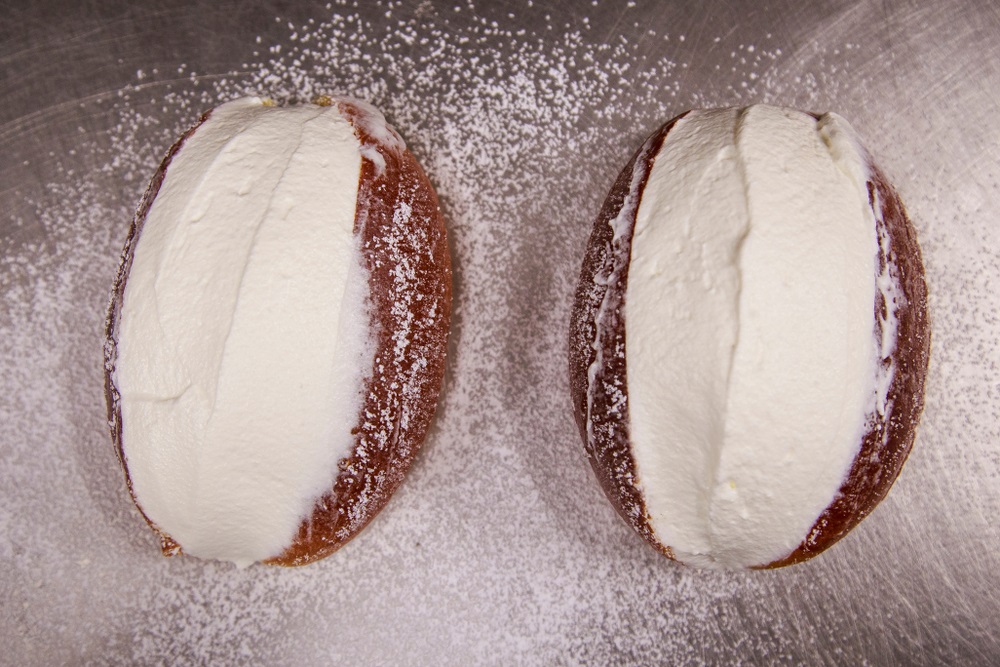
Maritozzi is a traditional sweet buns stuffed with whipped cream that dates back to ancient Roman times. The buns are made with a dough of flour, yeast, eggs, sugar, butter, salt, and fresh cream. Also, citrus zest, raisins, or pine nuts can be included for additional flavor. The name means almost-husband, as men would give the maritozzi to their fiancées with a gold trinket inside, customarily on the first Friday of March.
If you’re looking for a refreshing sweet treat during summer in Rome, try grattachecca, a shaved ice served with juice, syrup, and occasionally fresh fruit. It’s made by chipping ice shavings off a massive block of ice and is less smooth and refined than Sicilian granita.
Pangiallo, a traditional Christmas cake cherished in Lazio, is a centerpiece of festive celebrations. This delightful confection is crafted from a rich blend of nuts, candied citrus, figs, and honey, all encased in a smooth egg batter before baking. The egg batter, when baked, forms a lustrous, golden-yellow crust, giving pangiallo its name, which translates to ‘yellow bread.’ Harking back to ancient Roman times, pangiallo loaves were shared during the winter solstice as a symbolic gesture to beckon the sun’s return. Some recipes incorporate saffron into the batter to enhance its golden hue, deepening the cake’s vibrant yellow color and adding a luxurious flavor.
If you would like us to customize an exclusive luxury tour, contact us and let us know your travel plans. We offer luxury food and wine tours for private groups of a minimum two guests. In addition, all of our private, chauffeured tours are available year-round upon request.

